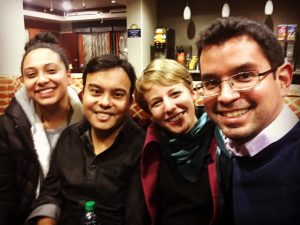
By Ernie Collette is a Government Benefits and Immigration Attorney at MFY Legal Services; Carlos A. Valenzuela, an Immigrant Justice Corps Fellow with the Safe Passage Project.
Photo Credit: Catholic Immigration Network.
Ernie and then Carlos share experiences of their first day.
Waking up to pitch black darkness at 6:40 AM, mist from the dense fog covers the car and blankets the sky as we make the 2-min drive to correctional facility in Dilley, Texas. A narrow, two-lane road takes us past a men’s correctional facility to a gravel parking lot where several trailers and flood lights brighten up the facility where we will work for the next week.
Passing a security line mixed with volunteers, medical staff, USCIS and ICE officers, and passing a short walkway, you see the tall chain-link fences and begin to feel surrounded; realizing that the term “baby jail” may be appropriate to describe both your workplace and where many families are introduced to the United States.
The screening room consists of one large trailer where volunteers arrive in one entrance and families through another. With the exception of offices, and a playroom for children, along the sides of the trailer, there are no walls to separate one end of the trailer from the other. As a result, everyone must interact with each other and it forces you to look out at the sea of people rotating in to ask for your help.
Christmas decorations cover the walls of the trailer, likely intending to add color and holiday cheer. However, the stories of families separated and family members killed due to gang violence makes the decorations, symbols of family gathering and celebration, seem surreal and out of place, even in mid-December.
Volunteers created two circles of chairs that would be used for intake and Credible/Reasonable Fear Screening “charlas,” or conversations. This is where we conduct conversations in Spanish to provide many of the women for the first time basic information about what their ICE paperwork means and to prepare them for any interactions they may have with immigration officers.
Our 14-hour day is divided into five two-hour screening sessions with a lunch break in between and a volunteer meeting at night. I spent the majority of my day conducting Credible or Reasonable Fear Interviews to prepare women and some children to speak in front of an asylum officer about their fears for returning to their home country. I meet many of the clients in bare-bones offices; just a desk, two chairs and a phone. Sometimes the air conditioning blasts cold air even though the temperature outside makes it more reasonable to simply open the window and let fresh air in.
It’s difficult to truly describe how powerful and gracious all of these women and children are to share their stories of death, family separation, and forced migration with a male stranger who’ve they’ve never met before. Some come into the office with eyes already red and swollen, tears beginning to form even before I have the opportunity to introduce myself. Others tell their story calmly but with a mixture of sadness and anger, only then pausing before starting to cry, making it feel as if you are seeing catharsis in its purest and most dispirited form. However, all leave me with the impression that while they are worried about the future, they all hold to the hope that they will be able to begin a life of peace and freedom for themselves and for their children that provided one possible reason for taking a dangerous journey to the United States.
Leaving the facility under darkness and mist from the fog leaves the impression that little time has passed since I began my first day. However, interacting and listening to such selfless and brave women and children reminds me both of the work done and what needs to be done, and provides me with some light at the end.
Carlos Valenzuela
Patience, grace, and resilience. These are the characteristics that encompass the detained women that I met with for the first time inside the South Texas Family Residential Center. They have just crossed the border into the United States less than a week ago. The women I see are courageous survivors of a life that has not been kind to them. And if detained women show any form of vulnerability, their young children give them the force and protection they need to continue the heart-wrenching process of being in detention.
The day started with an orientation about the types of assignments that need to be done throughout the 12-hour day. There were credible fear interview preparations, reasonable fear interview preparations, intake and interview talks, information input, and even child supervisions tasks to be done. I undertook the credible fear interview preparations task first because it is what seemed to be most familiar for me, as part of my job is to interview children in removal proceedings. However, the experience of interviewing a woman and her child was unprecedented for me.
I completed 7 interview preparations and 2 intake talks. It was a very long day, but while completing these tasks, I saw women sitting up straight and ready to listen. In two instances, however, there were women who had to hold their child in hand. There two women cried as they remembered the tragic events that scarred their lives. Both children woke up, seeming to sense their mother was vulnerable. Upon seeing their mothers cry both children immediately reacted. The first child wiped the tears from his mother’s face. The second one cried with her mother. The mothers stopped crying and held their children tightly.
I was not emotionally ready for that scene. Interviewing children in removal proceedings is compelling because they are so strong and ready to move their cases along. But watching women whose strength is rooted in their children’s survival was such an empowering image. Words cannot describe what it’s like to see the love between a child trying to protect his or her mother and a mother who does not want to disturb the innocence of her child. The families detained here humble me and I am inspired to continue working.




